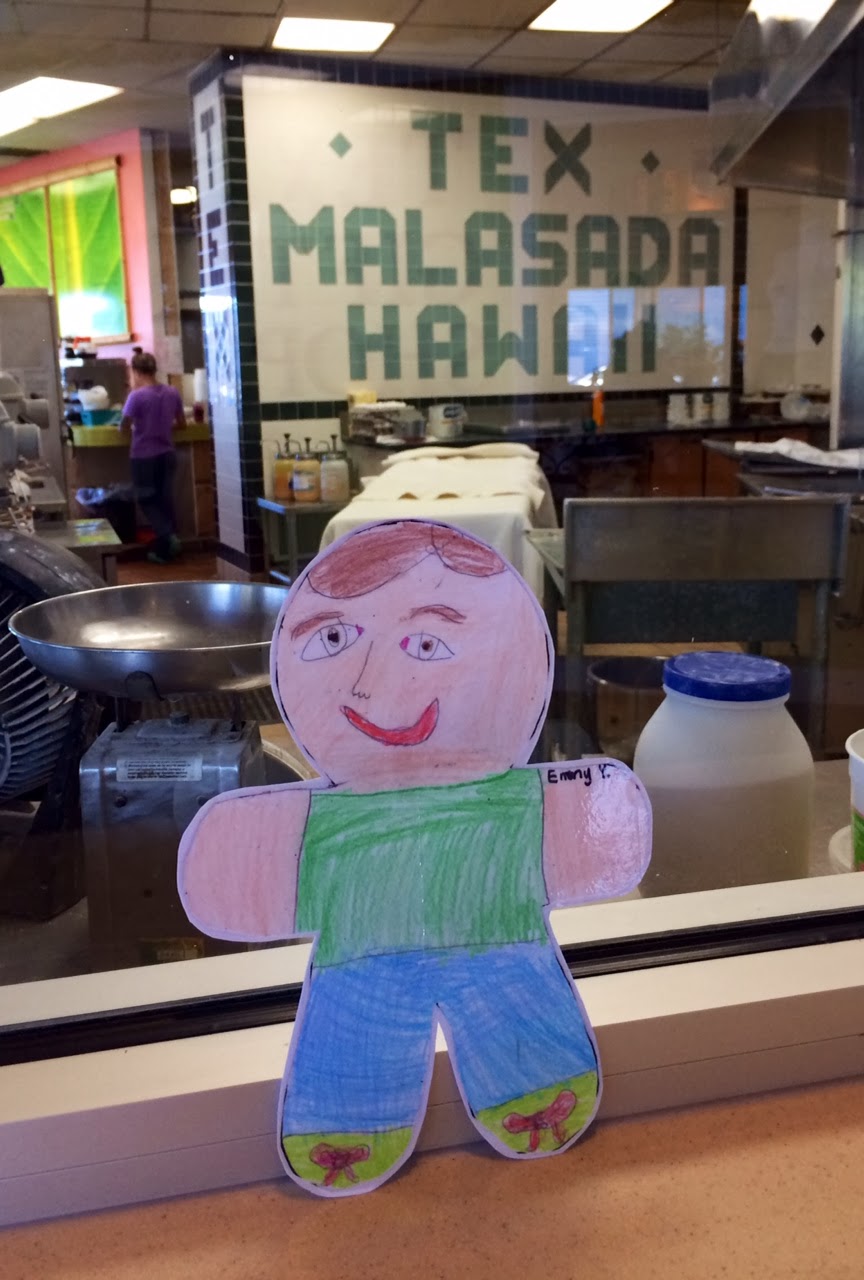Flat Stanley accompanied us to Honoka’a, Hawai’i (pronounced Ha-vai-ee in Hawaiian) to enjoy a yummy mango malasada at “Tex Malasada”. (Don’t ask why it’s called Tex—we don’t know.)
Malasadas are considered
‘Portuguese donuts’, deep fried yeast dough rolled in sugar. While they
are not traditionally filled or flavored, it is very common in Hawai’i to find
both flavored dough and fillings such as guava, pineapple, mango, coconut, and even chocolate
or vanilla cream. Malasadas were created originally on the isle of
Madeira and found their way to Hawai’i when Portuguese workers immigrated to
Hawai’i to work on sugar plantations.
Honoka’a is a small town
along the northern shore of the Big Island of Hawai’i and used to be home to
large sugar plantations.
Even though there are
hundreds of islands in the Hawai’i island chain, there are 8 main islands that
are the best known. They are Ni’ihau, Kaua’i, O’ahu, Moloka’i, Lana’i,
Kaho’olawe, Maui, and the Island of Hawai’i. The last is the
largest and is often called "The Big Island" to avoid confusing the
name of the island with the name of the state as a whole.
What is now the state of
Hawai’i was a sovereign kingdom until 1893 when the monarchy was overthrown by
resident American businessmen. It was an independent republic from 1894
until 1898, when it was annexed by the United States as a territory, and then
it became the 50th state of the United States in 1959. Hawai’i has a very diverse
population including a large percentage of Filipino, Japanese, Polynesian,
Chinese, Portuguese, as well as many others. As a result, many different
languages are spoken in Hawai’i and many different cultures are observed.
The official languages of Hawai’i are English AND Hawaiian.
Hawai’i is known for its warm
tropical weather and beautiful beaches and lush rainforests. But the Big Island
is also known for sometimes having snow on the summits of the Mauna Kea &
Mauna Loa mountaintops in the winter. The Big Island is also home to Kilauea,
an active volcano. http://hvo.wr.usgs.gov/kilauea/
Flat Stanley also visited the Waipiʻo Valley overlook. During rainy season there are beautiful waterfalls cascading down the slopes of the mountains surrounding these valleys.. "Waipiʻo" means "curved water" in the Hawaiian language. Located along the Hamakua Coast on the northeast shore of the Big Island of Hawai’i, the Waipiʻo Valley is the largest and most southern of the seven valleys on the windward side of the Kohala Mountains. The Waipiʻo Valley is a mile wide at the coastline and almost six miles deep. The Waipiʻo Valley is often referred to as the "Valley of the Kings" because it was once the home to many of the ancient rulers of Hawai’i. In the late 1800s many Chinese immigrants settled in the valley. At one time the valley had churches, restaurants and schools, but in 1946 the most devastating tsunami in Hawaii's history swept great waves far back into the valley. Afterwards most people left the valley, and it has been sparsely populated ever since. A severe deluge in 1979 covered the valley from side to side in four feet of water. Today only about 50 people live in the Waipiʻo Valley. Many are farmers who raise taro which is used to make poi.
Another day Stanley went with his friends to Hilo on the east side of the island. He got to see a Banyan tree which has HUGE roots above ground.
And on another day he visited Lapakahi State Park. Lapakahi State Historical Park is a large area of ruins from an Ancient Hawaiian fishing village in the North Kohala District on the Big Island of Hawaiʻi. The park is very old and even still has the remains of an old thatched roof shed. You can also just sit on the hilltop and rest after walking around the area, and some days you will see humpback whales. Unfortunately Stanley didn't see any on his visit.
Or maybe just enjoy a nice sunset along the roadside on the Queen Ka'ahumanu Highway.
Or maybe join his friends for a little music. This is Asia and she plays the stand up bass, and she also dances hula. But what Stanley really enjoyed was going to a lu'au (pronounced loo-ow). A lu'au is a Hawaiian word for a big party or celebration. There is lots of food & music & hula dancing at a lu'au. This lu'au was held by the ocean side, and some Hawaiian friends even made Stanley a skirt out of leaves similar to ti leaf skirts some dancers wear. He got to dance with some of the dancers in the show in their exciting & colorful costumes.
But all good things must end, and Stanley finally had to leave Hawai'i and return to the mainland. But before he left, he had an early Valentine dinner with his new Hawaiian friends Wehi and Wekiu. He even got a fragrant flower lei (pronounced lay) to wear home.


















